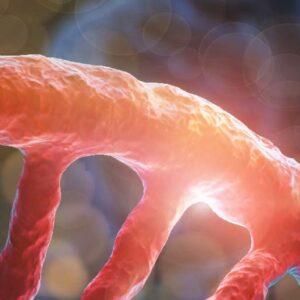SCIENTIFIC BACKGROUND
Hemochromatosis is a so-called late-onset disease based on an acquired (secondary) or congenital (hereditary) disorder of iron metabolism. The age of manifestation is usually between the 4th and 6th decade of life in men, and around the age of 50 in women. Increased iron absorption in the small intestine results in iron accumulation in various organs, especially the liver. If diagnosed early, the disease is easily treatable but, if left untreated, it often leads to liver cirrhosis, liver tumors, diabetes mellitus, or cardiac arrhythmias. The hereditary form (hereditary hemochromatosis, HH) is caused in approximately 80% of cases by homozygosity for the amino acid exchange p.(Cys282Tyr) (C282Y; rs1800562) in the autosomal recessive HFE gene. The frequency of this genotype is between 1:200 and 1:400 in Central Europe. Penetrance is incomplete so that only 15-25% of homozygous trait carriers develop clinically manifested hemochromatosis. Detection of this genotype in symptomatic patients can be considered as confirmation of HH. Heterozygous trait carriers (5-10% of the population) do not have an increased risk of the disease. The amino acid substitution p.(His63Asp) (H63D; rs1799945) is not associated with hereditary hemochromatosis. However, in the homozygous form, it is a risk factor for mild iron accumulation, especially in combination with other risk factors such as alcohol, obesity, or certain metabolic diseases.
In patients with suspected hereditary hemochromatosis due to a transferrin saturation of >45% and a serum ferritin level of >200 µg/l, genetic testing of the HFE gene (basic diagnostic genotyping) is recommended.
Extended molecular genetic diagnostics are indicated in patients with inconspicuous basic diagnostics and severe iron overload detected by liver biopsy, magnetic resonance imaging, or quantitative phlebotomy, in whom other liver diseases or hematological disorders have been ruled out. This includes the option of detecting rare variants in the HFE, HJV (aka HFE2), HAMP, TFR2, SLC40A1, and BMP6 genes.
Juvenile hemochromatosis typically occurs in the first to third decade of life and is characterized by the presence of severe iron overload (serum ferritin concentration of 1,000 to 7,000 µg/l) and very high transferrin saturation, often reaching 100%. Men and women are equally affected. Prominent clinical features include hypogonadotropic hypogonadism, cardiomyopathy, and liver cirrhosis. The major cause of death is cardiac disease. If juvenile hemochromatosis is detected early enough and phlebotomy is performed regularly, morbidity and mortality are greatly reduced. Alterations in genes that cause juvenile hemochromatosis involve the HJV gene, which codes for hemojuvelin and causes more than 90% of cases, and the HAMP gene, which codes for hepcidin and causes less than 10% of cases. Both genes are inherited in an autosomal recessive pattern.
In patients with proven hereditary hemochromatosis, lifelong regular phlebotomy is the recommended therapy, leading to normal life expectancy if started early. If phlebotomy cannot be performed, therapy with chelates may be considered. A healthy, balanced diet is recommended.
References
Barton J.C. et Edwards C.Q. 2018, GeneReviews® [Internet] / De Gobbi M. et Roetto A. 2018, GeneReviews® [Internet] / Rihl M. 2017, Akt Rheumatol 42:529 / Wang et al. 2017, Int J Hematol 105:521 / Porto et al. 2016, Eur J Hum Genet 24:479 / Goldberg Y.P. 2011, GeneReviews® [Internet] / Clark et al. 2010, Clin Biochem Rev 31:3





















